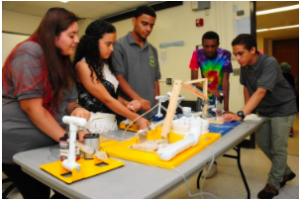It’s all the buzz right now, so what is a STEM curriculum? The acronym STEM stands for science, technology, engineering and mathematics. It’s an approach to education that’s designed to revolutionize the typical teaching of subjects like math and science by incorporating technology and engineering into regular curriculum.
STEM Education shifts the typical teacher-centered classroom by encouraging a curriculum that is driven by problem-solving, discovery, exploratory learning and hands-on activities. Some programs have added “A” for art making the acronym “STEAM”. By adding art, educators are promoting creativity and flexible thinking among students in a science and mathematics context.
Workforce and economic development experts strongly support the need for a STEM/STEAM focus, which may be why it’s such a hot topic right now:
- According to the U.S. Department of Commerce’s Economics & Statistics Administration, career opportunities related to STEM over the past ten years have grown three times as fast as non-STEM jobs.
- In 2018, there are projected to be 2.4 million STEM jobs in the U.S that could go unfilled due to the lack of qualified workers.
- STEM occupations have wages significantly above the national average wage for all occupations. The national average wage for all STEM occupations was $87,570, nearly double the national average wage for non-STEM occupations ($45,700).
In a recent project, our team worked with an organization to apply for a 21st Century Community Learning Center (CCLC) grant. This non-profit organization offers after-school programming for middle school and high school students. Part of their grant application included implementing STEAM in their weekly curriculum and connecting students to local STEAM career pathways. As we worked to implement this curriculum shift, the organization saw four major benefits.
Benefits of a STEAM / STEM Curriculum :
- Help students accomplish their postsecondary education attainment and career goals.
- Address the community’s career pathways gap.
- Pave the way for new partnerships.
- Open doors for securing additional funding to sustain the program.
1. Help students accomplish their postsecondary education attainment and career goals.
By offering STEM / STEAM focused curriculum, you are supporting students’ development of skills, knowledge, and experiences necessary for success in postsecondary education and economically viable career options. This focus encourages strong community partnerships, which allow students to participate in internships and apprenticeships. It also provides additional opportunities for creative and innovative academic enrichment that support students in developmental areas such as academic, social/emotional, civic engagement, wellness, etc. By exposing students to various STEM / STEAM careers, it helps them identify their postsecondary education and career pathway.
2. Address the community’s career pathways gap.
By offering a STEM / STEAM program, you can help set your community up for success by encouraging skills needed for the local workforce. In our example regarding the 21st CCLC grant application, we found that a STEM / STEAM focus for students could really pay off for the entire county. In one school district included in the program, 55% of the students enrolled in college within a year following graduation. Unfortunately, the students are not persisting through completion. Currently, only 29% of the county adults hold an Associate’s degree or higher. That is less than half of the students who enrolled in postsecondary education and the state’s projected goal and need for 60% of adults to have postsecondary education. In this same community, manufacturing jobs – high-skilled and high paying jobs – represent almost half of the employment in the county. Expanding students’ knowledge of STEM-related careers and creating stronger partnerships as well as career pathways will be a game changer in this county!

3. Pave the way for new partnerships.
With a structured STEM / STEAM curriculum, organizations can pull in local partnerships to enhance programming. With the organization mentioned above, we had numerous businesses in the community agree to facilitate field trips, presentations, and hands on activities to enrich the programming for students while also educating the students about local career pathways available. This is invaluable experience for a student who is trying to figure out what their options are after graduation. It is also a beneficial partnership for businesses who need to maintain their workforce pipeline.
4. Open doors for securing additional funding to sustain the program.
Because STEM / STEAM is all the hype right now, there are numerous funding streams available to support your work. Funders see this as a significant need in our education and workforce systems and are looking to support organizations who can successfully address this need. For the 21st CCLC grant, priority points were given to organizations who included STEM / STEAM in their programming. There is ample data available to convince local businesses and philanthropic partners to invest. Having a clear, focused curriculum in place can open NEW doors for additional funding streams.
As education and technology continues to transform the way we live, work, and learn, STEM / STEAM is something to consider for organizations serving young people. If your organization is ready to take the plunge and shift your curriculum focus, we’d love to work with you. We can help find funding, research programs, write your grant, evaluate existing efforts, and more. Contact us today and let’s chat!

